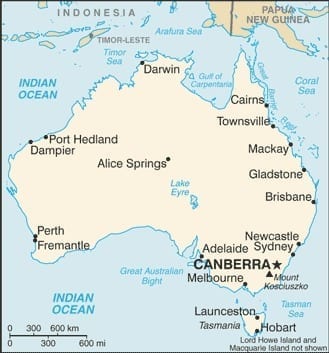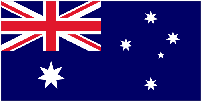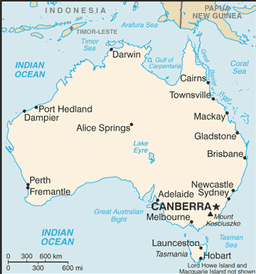Official Name: Commonwealth of Australia
Internet Domain: .au
International Dialing Code: +61
| Location and Size | Credit and Collections |
| Government | Risk Assessment |
| Legal System | Business Climate |
| Economy | Business Protocol |
| Comparative Economic Indicators |
Location and Size
Australia is situated between the Indian Ocean and the South Pacific Ocean in an area of the world referenced as Oceania. Oceania comprises Australia, New Zealand, Papua New Guinea and numerous other island states. Australia’s total area (land and sea) is 7,741,220 sq km, making it the sixth largest country in the world ” just slightly smaller that the contiguous 48 U.S. states. It is also the smallest continent in the world.
Government
Australia is a federal parliamentary democracy and a Commonwealth realm made up of 6 states and 2 territories.
Branches:
- Executive: Chief of state Queen Elizabeth II represented by Governor General David HURLEY; Head of Government Prime Minister Scott MORRISON; Cabinet nominated by prime minister
- Legislative: Bicameral Federal Parliament consisting of the Senate (76 seats) and the House of Representatives (151 seats)
- Judicial: High Court consisting of a chief justice and six other justices. Appointed for life with mandatory retirement at age 70
Legal System
The legal system is based on English common law. Australia has accepted compulsory International Court of Justice (ICJ) jurisdiction with reservations. The country also accepts International Criminal Court (ICC) jurisdiction with conditions.
Economy
The Australian economy has experienced continuous growth and features low unemployment, contained inflation, very low public debt, and a strong and stable financial system. Demand for resources and energy from Asia and especially China has grown rapidly, creating a channel for resources investments and growth in commodity exports. The high Australian dollar has hurt the manufacturing sector, while the services sector is the largest part of the Australian economy, accounting for about 70% of GDP and 75% of jobs. Australia was comparatively unaffected by the global financial crisis as the banking system has remained strong and inflation is under control. Australia has benefited from a dramatic surge in its terms of trade in recent years, stemming from rising global commodity prices. Australia is a significant exporter of natural resources, energy, and food. Australia’s abundant and diverse natural resources attract high levels of foreign investment and include extensive reserves of coal, iron, copper, gold, natural gas, uranium, and renewable energy sources. A series of major investments, such as the US $40 billion Gorgon Liquid Natural Gas project, will significantly expand the resources sector.
Leading Markets (2017): China 33.5%, Japan 14.6%, South Korea 6.6%, India 5.0%,Hong Kong 4.0%
Leading Exports – Commodities: coal, iron ore, gold, meat, wool, alumina, wheat, machinery and transport equipment
Leading Suppliers (2017): China 17.94%, US 11.26%, Japan 8.36%, Thailand 5.81%, Singapore 5.54%, Germany 5.3
Leading Imports – Commodities: Machinery and transport equipment, computers and office machines, telecommunication equipment and parts; crude oil and petroleum products
Top Industries: Mining, industrial and transportation equipment, food processing, chemicals, steel
Top Agricultural Products: Wheat, barley, sugarcane, fruits; cattle, sheep, poultry
Comparative Economic Indicators ” 2018
| Australia | New Zealand | Papua New Guinea | Indonesia | Malaysia | United States | |
| Population* (millions) | 23.4 | 4.5 | 7.0 | 262.7 | 31.8 | 329.2 |
| Population growth rate* (%) | 1.01 | 0.77 | 2.1 | 0.83 | 1.34 | 0.8 |
| Literacy (%) | 99.0 | 99.0 | 63.4 | 93.59 | 90.75 | 99.0 |
| Unemployment rate (%) | 5.6 | 4.7 | 2.5 | 5.4 | 3.4 | 4.4 |
| Inflation (%) | 2.0 | 1.9 | 5.4 | 3.8 | 3.8 | 2.1 |
| Population below poverty line (%) | N/A | N/A | 37.0 | 10.9 | 3.8 | 15.1 |
| GDP** (USD billions) | 1,248.0 | 189.0 | 30.19 | 3,2509.0 | 933.3 | 19,490 |
| GDP real growth rate (%) | 2.2 | 3.0 | 2.5 | 5.1 | 5.9 | 2.2 |
| GDP per capita** (USD) | 50,400 | 39,000 | 3,700 | 12,400 | 29,100 | 59,800 |
| Public debt (% of GDP) | 40.8 | 31.7 | 36.9 | 28.8 | 54.1 | 78.8 |
| Exports (USD billions) | 231.6 | 37.35 | 8.52 | 168.9 | 187.9 | 1,553.0 |
| Imports (USD billions) | 221.0 | 39.74 | 1.87 | 150.1 | 160.7 | 2,361.0 |
| Foreign exchange and gold reserves (USD billions) |
66.50 | 20.68 | 1.73 | 130.2 | 102.4 | 123.3 |
| Currency |
Dollar
AUD
|
Dollar
NZD
|
Kina
PGK
|
Rupiah
IDR
|
Ringgit
MYR
|
Dollar
USD
|
| Exchange rates (per USD) | 1.47 | 1.57 | 3.40 | 14,122.20 | 4.19 | N/A |
| Exchange rates (per EUR) | 1.62 | 1.74 | 3.75 | 15,575.98 | 4.62 | 1.10 |
* December, 2017 estimates
** PPP ” Purchasing Power Parity
Data from CIA World Factbook
Credit and Collections
Dispute Resolution
The Australia-U.S. Free Trade Agreement (AUSFTA) establishes a dispute settlement mechanism for disputes arising under the Agreement. The mechanism provides for compensation for breaches of the agreement, which may include requiring the breach to be corrected, trade compensation to be provided, or monetary compensation in lieu of trade compensation.
Property and contractual rights are enforced through the Australian court system, which is based on English Common Law.
Risk Assessment
Coface Country Rating: A2 ” The political and economic situation is good. A quality business environment has a positive influence on corporate payment behavior.
Coface Business Climate Rating: A1 — Corporate default probability is very low on average.
Credendo Political Risk: 1 ” very low, 7 represents highest risk
Credendo Commercial Risk: B ” mid-level, A is lowest risk, C is highest
Business Climate
Australia has proven to be an appealing and profitable market for American companies for many years. It offers very few barriers to entry, a familiar legal and corporate framework, and a sophisticated — yet straightforward — business culture.
The Australia-U.S. Free Trade Agreement (AUSFTA) enhances a long and successful trading relationship by eliminating tariffs on almost all manufactured and agricultural goods. AUSFTA is a comprehensive agreement that covers goods, services, investment, financial services, government procurement, standards and technical regulations, telecommunications, competition-related matters, electronic commerce, intellectual property rights, labor and the environment. The agreement has guaranteed U.S. access to the Australian market and the gradual expansion of this access. Under the FTA, trade in goods and services as well as foreign direct investment continued to expand. More than 99% of U.S. exports of manufactured goods are now duty-free.
Market Access: The Australian Government supports the negotiation of comprehensive Free Trade Agreements (FTAs) that are consistent with the World Trade Organization rules and guidelines. Australia has FTAs with the United States, Thailand, Singapore, Chile, and has reached agreement on a multilateral FTA with New Zealand and the countries of the Association of Southeast Asian States (ASEAN).
Intellectual Property Rights: Protection of intellectual property rights meets or exceeds world standards. Contracts are secure, and expropriation is highly unusual. The rule of law is seen as fundamental, and enforcement is even-handed. The government respects the independence of the judiciary.
Conversion and Transfer Policies: The Australian dollar is a fully convertible currency. The government does not maintain currency controls or limit remittance, loan or lease payments. Such payments are processed through standard commercial channels, without governmental interference or delay.
Economic Freedom: The Heritage Foundation’s 2019 Index of Economic Freedom scores Australia at 80.9, making its economy the 5th freest in the 2019 Index. Australia is ranked 4rd out of 25 countries in the Asia”Pacific region, and its score is well above regional and world averages.
Corruption: Australia maintains a thorough system of laws and regulations designed to counter corruption, which is perceived as minimal.
Political Violence: As in all liberal democracies, political protests form an integral, though minor, part of Australian cultural life. Such protests rarely degenerate into violence.
Business Protocol in Australia
Australians are very matter of fact when it comes to business. They generally do not require longstanding personal relationships before doing business. Many business deals are made in a social environment, and it is not unusual to conduct a meeting over breakfast, lunch, dinner and, with the cafe culture on the rise, even in coffee shops.
Australians are very down-to-earth and direct when it comes to talking business. They generally prefer direct eye contact and consider it a sign of respect, indicating that the person is listening. Present your business case with facts and figures.
Decision-making is concentrated at the top of the company, although decisions are made after consultation with subordinates, which can make the process seem slow and protracted.
Australians rely on written agreements when doing business as they like to prevent misunderstandings and potential problems.
Business dress is conservative in Melbourne and Sydney. In Brisbane or other tropical areas, depending on the job function and company culture, men may wear shirts, ties and Bermuda shorts.
**********
Subscribe to the Credit-to-Cash Advisor
Monthly e-Newsletter — It’s Free
This information is provided by ABC-Amega Inc. Providing international receivable management and debt collection services for exporters to more than 200 countries including Australia. For further information, contact [email protected].
This report represents a compilation of information from a wide variety of reputable sources.
Comparative Economic Indicators: CIA World Factbook
Risk Assessment information: Coface Country Rating and Credendo.
Exchange Rates: OANDA.com The Currency Site.


